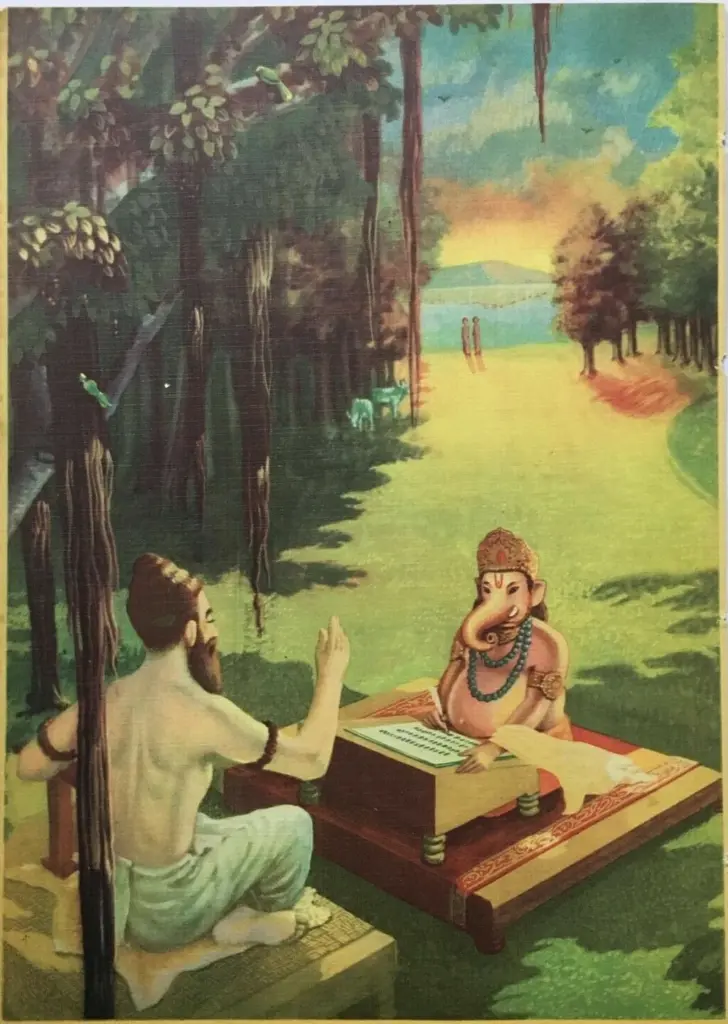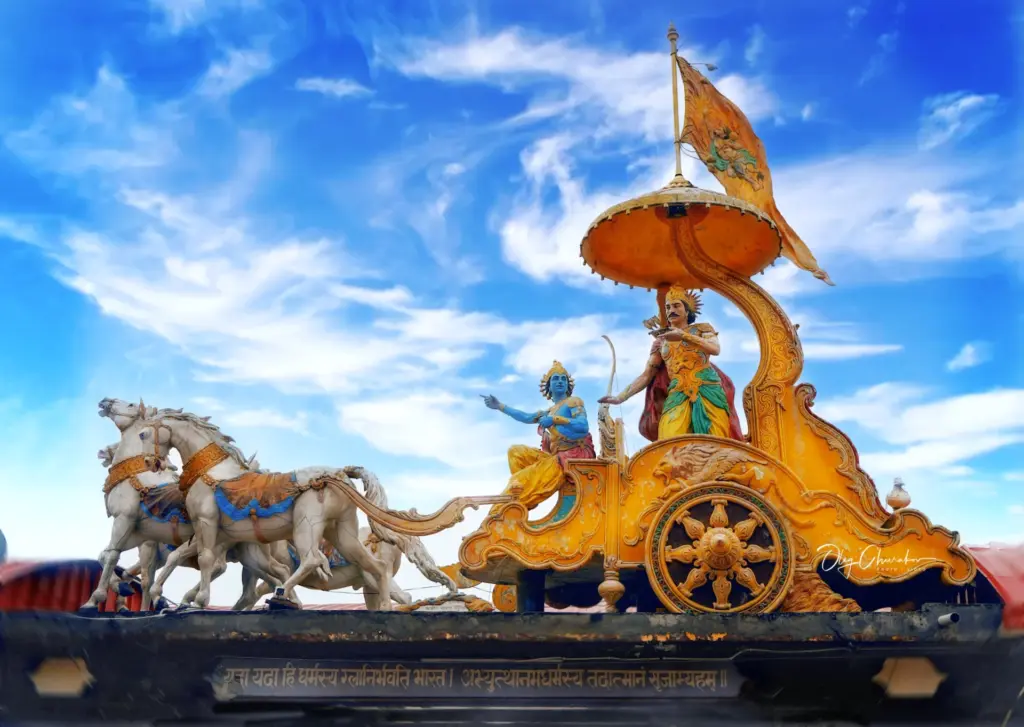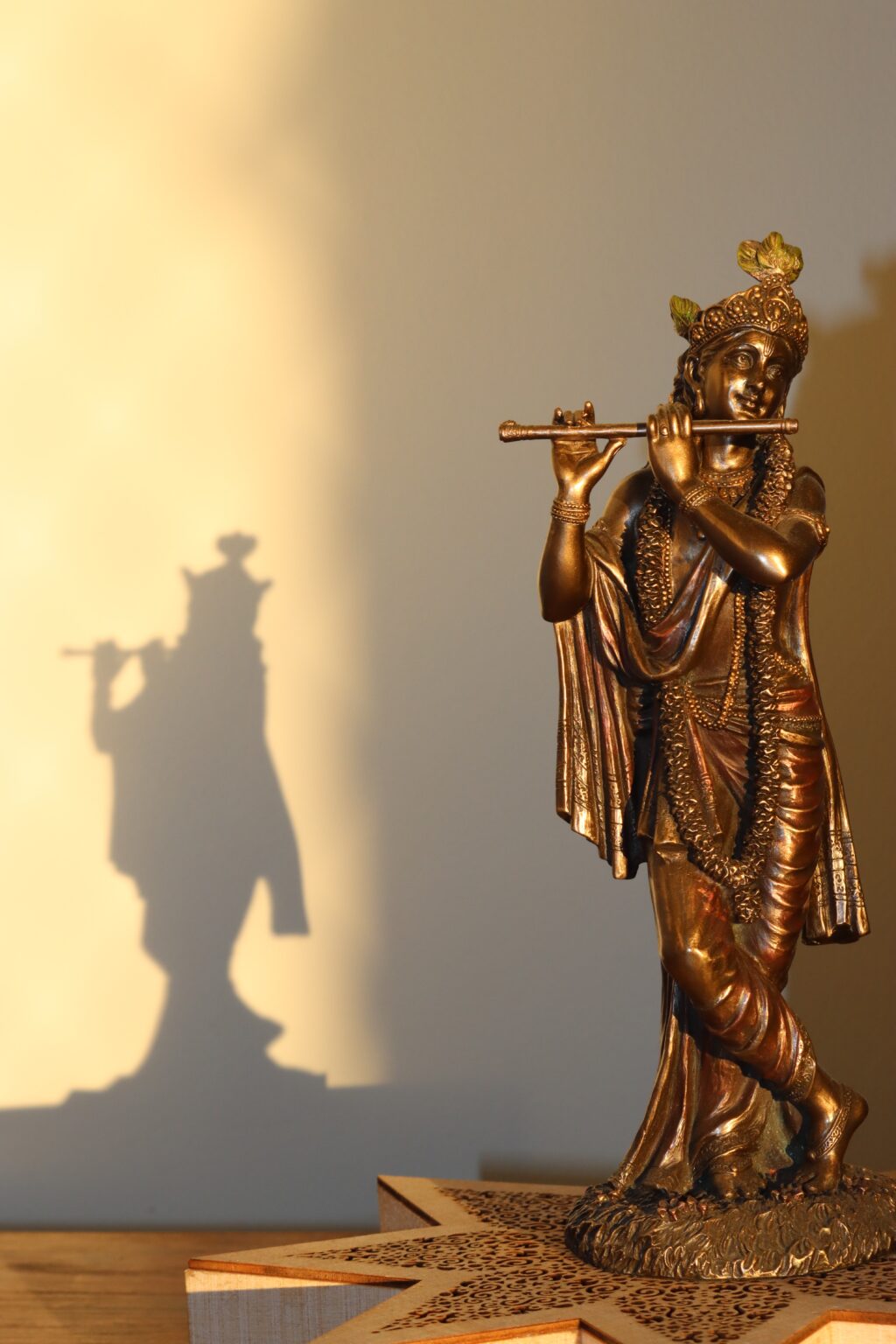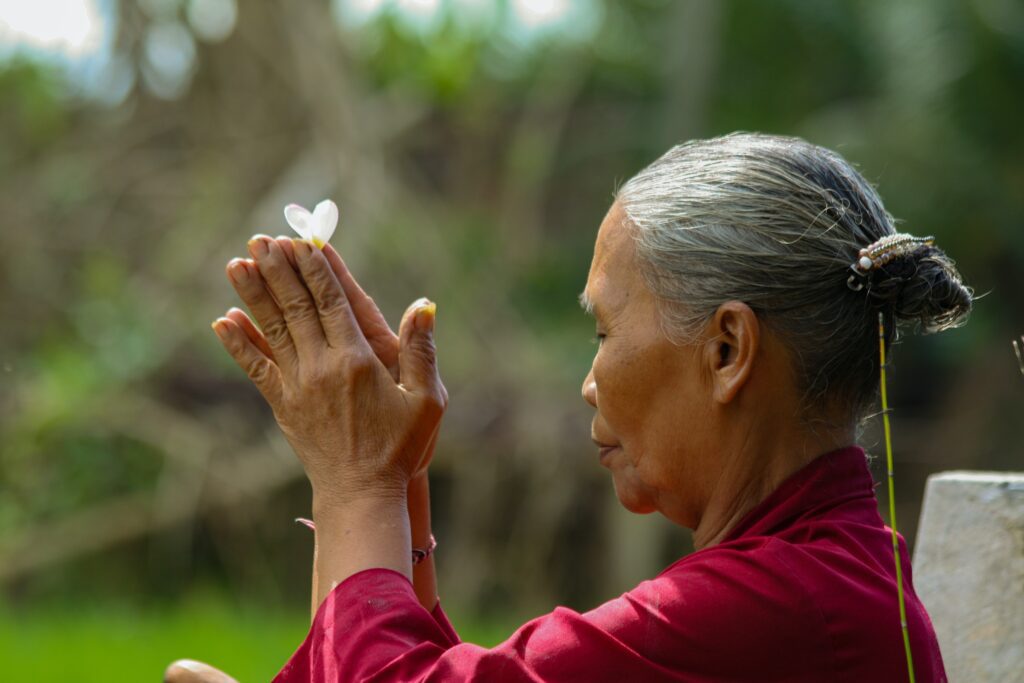Welcome to a journey through one of the world’s most profound spiritual treasures, the Bhagavad Gita.
This ancient Indian scripture is more than just a religious text; it’s a guide to living a life of meaning, purpose, and enlightenment.
The Bhagavad Gita, often referred to simply as the Gita, presents a dialogue between the prince Arjuna and the god Krishna, who serves as his charioteer.
In Hindu philosophy, the Gita occupies a place of honor, revered for its deep spiritual insight and practical wisdom.
The Gita addresses the eternal struggles of the human condition, offering guidance on how to navigate the complexities of duty (dharma) and spiritual growth.
The themes of the Bhagavad Gita are as relevant today as they were thousands of years ago. It speaks to the inner battles we all face, the conflicts between our desires and our duties, and the quest for a deeper understanding of life.
As we embark on this exploration of the Bhagavad Gita’s most impactful life lessons, prepare to open your mind and heart to a transformative experience. These teachings, distilled from one of humanity’s greatest philosophical gems, offer a path to a more fulfilling, aware, and serene life.
Table of Contents
Toggle
Origin of the Bhagavad Gita
The Bhagavad Gita finds its place within the epic Indian narrative, the Mahabharata. This grand epic, one of the two major Sanskrit epics of ancient India (the other being the Ramayana), narrates the history of the Kurukshetra War and the fates of the Kaurava and the Pandava princes. Embedded in this vast and complex story is the Gita, a concise but immensely profound dialogue occurring just before the onset of this great battle.
If you want to read more about the Mahabharata, you can click here.
The epic is traditionally dated to the Dvapara Yuga, one of the four ages (Yugas) in Hindu scriptures, placing it several millennia ago. However, historians often suggest a period between 400 BCE and 200 CE for the final form of the text.

What is the Bhagavad Gita?
The Bhagavad Gita comprises 18 chapters and is a 700-verse segment in the Mahabharata, each chapter serves as a spiritual conversation between Lord Krishna and Arjuna.
These chapters are structured as a dialogue, allowing for a deep exploration of philosophical and ethical issues. The text is written in a poetic form, with each verse (or shloka) conveying profound truths in a concise manner. This poetic structure not only lends itself to the beauty of the scripture but also facilitates memorization and recitation, key aspects of its traditional transmission.
The Gita explores the nature of life, the soul, and the universe. It discusses the importance of duty (dharma), the nature of action (karma), and the path to spiritual realization (moksha).
One of the Gita’s most significant contributions to philosophy is its synthesis of different paths to spiritual growth: the paths of knowledge (Jnana yoga), action (Karma yoga), and devotion (Bhakti yoga).
This synthesis offers a holistic approach to spirituality, accommodating diverse temperaments and life situations.
Terms to Remember
-
Dharma (Duty): The Gita emphasizes the importance of performing one’s duty in accordance with one’s nature and position in life.
-
Yoga (Union): Yoga, in the Gita, is portrayed not just as physical exercise but as a metaphor for the union of the individual soul with the universal spirit. It represents the journey of self-transcendence and spiritual evolution.
-
Moksha (Liberation): Moksha is the ultimate goal in the Gita or even in Hinduism as a whole. It represents freedom from the cycle of birth and death (samsara) and the realization of one’s true, eternal nature.

Meet Krishna and Arjuna
The Bhagavad Gita centers around a dialogue between two pivotal characters: Lord Krishna and Prince Arjuna.
Lord Krishna, who is an incarnation of the god Vishnu, serves as his charioteer and guide. Krishna’s presence in the Gita is profound, offering a divine perspective to the human concerns voiced by Arjuna. I’m sure you have heard of the Hare Krishna mantra somewhere before.
Arjuna, a skilled warrior and prince, represents the human spirit caught in the throes of moral and existential dilemmas.
The relationship between Krishna and Arjuna in the Gita is multi-dimensional. On the surface, it is that of a charioteer and a warrior. However, on a deeper level, it symbolizes the relationship between the divine and the human, the eternal and the temporal.
Krishna plays the role of a teacher and guide, imparting wisdom to Arjuna, who is confused and morally torn at the prospect of fighting his own kin. This dialogue represents the journey every human being undertakes in the quest for self-knowledge and spiritual clarity.
Krishna’s role in the Bhagavad Gita transcends that of a mere advisor. He is portrayed as the supreme being, embodying divine wisdom and universal truths. His teachings are not just for Arjuna but for all of humanity.

The Setting: Kurukshetra
The Bhagavad Gita unfolds on the battlefield of Kurukshetra, a vast field that was to be the site of an epic battle between the Pandavas and the Kauravas. This battlefield, described in vivid detail in the Mahabharata, is portrayed as a grand stage set for a conflict of monumental proportions.
It is here, amidst the assembled armies, with warriors ready to engage in combat, that the dialogue of the Gita takes place.
Kurukshetra represents the field of life, where good and evil, wisdom and ignorance, strength and weakness all come together in a grand struggle. This battlefield is a metaphor for the human condition, where every individual faces their own battles and moral choices.
The struggles and conflicts that take place on Kurukshetra mirror the inner conflicts that each person experiences in their journey through life.
As Arjuna gazes across the field, he sees relatives, teachers, and revered figures on both sides, and the prospect of fighting them plunges him into deep inner turmoil. He is torn between his duty as a warrior and his love and moral convictions. It is at this critical moment, filled with doubt and despair, that he turns to Krishna for guidance.
Krishna then guides Arjuna through a transformative journey, from confusion and despair to understanding and enlightenment.
Philosophical Foundations
Fate and Free Will: The Gita also explores the interplay between Fate and Free Will. It suggests that while certain aspects of life are predestined, humans have the free will to choose their path and actions.
Nature of Reality: The Gita discusses the transient nature of the physical world and the eternal, unchanging nature of the spiritual realm. It teaches that understanding the impermanent nature of the material world is key to spiritual growth and enlightenment.
Atman (Self): A central tenet of the Gita is the concept of the Atman, the eternal, unchanging soul present in every being. The Gita teaches that realization of the Atman, understanding its true nature, is crucial for liberation.
Brahman (Universe): The Gita describes Brahman as the ultimate, unmanifested, eternal reality that encompasses everything. It teaches that the individual soul (Atman) is a part of this universal spirit (Brahman), and unity (Yoga) with Brahman is the ultimate goal (Moksha) of spiritual pursuit.
15 Life Lessons from the Bhagavad Gita

1. The Power of Right Action
Karma Yoga, as taught in the Bhagavad Gita, is the discipline of selfless action. It is about performing one’s duty with dedication, but without attachment to the results. This teaching is a cornerstone of the Gita’s philosophy, encouraging us to engage in actions as a form of service, while maintaining a state of inner detachment from the fruits of those actions.
Bhagavad Gita 2:47: “Your right is to perform your work only, but never to its fruits. Let not the fruits of action be your motive, nor let your attachment be to inaction.”
Bhagavad Gita 3:19: “Therefore, without being attached to the fruits of activities, one should act as a matter of duty, for by working without attachment one attains the Supreme.”
The lesson of Karma Yoga is immensely practical and relevant in everyday life. It teaches us to focus on our actions, doing our best in all endeavors, but relinquishing the need to control the outcome. This approach leads to a more balanced life, free from the anxieties that come with attachment to results. It encourages a mindset where the journey and the act of doing become more important than the destination.
By internalizing this principle, we can transform our daily activities, regardless of their nature, into a spiritual practice. This shift in perspective can lead to profound changes in how we approach our work, relationships, and life challenges, fostering a sense of peace and contentment in the midst of life’s inevitable ups and downs.
2. The Path of Knowledge
Jnana Yoga, or the path of knowledge, is a journey towards understanding the true nature of reality and the self. This path is about discerning the eternal truth through self-inquiry and wisdom. It involves a deep exploration into the nature of existence, leading to the realization of one’s true self beyond the physical and ephemeral.
Bhagavad Gita 4:38: “In this world, there is nothing as purifying as knowledge. One who has attained purity of heart through a prolonged practice of Karmic Yoga automatically sees the light of truth in the self in due course of time.”
Bhagavad Gita 13:3: “You should understand that I am also the Knower in all bodies, and to understand this body and its knower is called knowledge.”
The integration of Jnana Yoga and the understanding of the Koshas invites a holistic view of the self. It’s not just about intellectual knowledge but also about experiential wisdom, recognizing and experiencing the deeper dimensions of one’s existence. By understanding these layers, one can move beyond the limitations of the physical body and the ego, and come to experience the true essence of the self – which is pure consciousness and bliss.

3. The Role of Devotion
Bhakti Yoga, the path of devotion, is about cultivating a deep, personal relationship with the divine through love, faith, and surrender. This path emphasizes the heart’s role in spiritual practice, suggesting that pure devotion and love for God can lead to spiritual liberation.
-
Bhagavad Gita 9:26: “If one offers Me with love and devotion a leaf, a flower, fruit, or water, I will accept it.”
-
Bhagavad Gita 18:65: “Always think of Me, become My devotee, worship Me, and offer your homage unto Me. Thus you will come to Me without fail. I promise you this because you are My very dear friend.”
The Bhagavad Gita presents a unique synthesis of different spiritual paths. It acknowledges that the paths of Karma (action), Jnana (knowledge), and Bhakti (devotion) are interconnected and lead to the same ultimate reality. This teaching is a powerful reminder of the unity underlying diverse spiritual practices all around the world
- Bhagavad Gita 4:11: “In whatever way people surrender unto me, I reward them accordingly. Everyone follows my path in all respects, O son of Pritha.”
Spirituality is a deeply personal journey, and one’s path may differ from others. It encourages an attitude of respect and openness towards various spiritual practices, emphasizing that the essence of all paths is the same — the quest for union with the divine.
4. Harnessing the Strength of Conviction
Shraddha, is a term that embodies a profound sense of trust that is deeply rooted in the heart. In the context of spiritual practice, Shraddha is the unwavering confidence in one’s path, teachings, and ultimate goal. It is the inner strength that fuels perseverance, commitment, and a deep understanding of one’s spiritual journey.
Bhagavad Gita 4:39: “A person who has faith and is sincere and has mastery over the senses gains this knowledge. Having gained this knowledge, one at once attains supreme peace.”
Bhagavad Gita 17:3: “O Bharata, according to one’s existence under the various modes of nature, one evolves a particular kind of faith. The living being is said to be of a particular faith according to the modes he is situated in.”
Shraddha is not passive belief but an active, dynamic force. It involves a heartfelt dedication to one’s spiritual practices, a steadfast commitment to truth, and an unshakeable confidence in the journey, even in the face of obstacles and challenges. It is about aligning one’s thoughts, words, and actions with one’s deepest convictions and spiritual understanding.
In practical terms, Shraddha can manifest as a deep trust in the process of life, a firm belief in one’s values and principles, and a resolute adherence to one’s chosen path. It’s about living with authenticity and integrity, guided by an inner compass that is aligned with spiritual truth.

5. The Practice of Detachment
Vairagya is a key concept that encourages detachment from the transient pleasures of the material world. It’s about cultivating an inner state where one’s happiness and peace are not dictated by external circumstances but rather found within. Vairagya is not necessarily renouncing the world, but it’s more like developing a mindset where one engages with the world without being ensnared by its allure.
Bhagavad Gita 2:62-63: “While contemplating the objects of the senses, a person develops attachment for them, and from such attachment lust develops, and from lust anger arises. From anger, complete delusion arises, and from delusion bewilderment of memory. When memory is bewildered, intelligence is lost, and when intelligence is lost, one falls down again into the material pool.”
Bhagavad Gita 6:35: “The mind is restless, turbulent, strong and unyielding, O Krishna, I think it is as difficult to control as the wind.”
Practicing Vairagya involves a conscious effort to remain equanimous and centered, regardless of the external situation. Cultivating a sense of inner contentment and peace that is independent of external successes or failures, gains or losses, this practice allows one to engage fully in life’s activities while maintaining an inner sense of clarity.
The practice of Vairagya eventually leads to a life of greater freedom. It liberates us from the endless cycle of desire and disappointment, enabling us to experience a deeper sense of fulfillment.
6. The Power of Discernment
Viveka, or discernment, is a key principle highlighting the importance of wisdom in making choices. It involves the ability to distinguish between what is eternal and what is temporary, what is right and what is wrong. This faculty of discernment is crucial, especially in complex moral and ethical situations (Dharma Sankat) where the lines between duty and desire, can often become blurred.
Bhagavad Gita 2:50: “Endowed with wisdom (buddhi), one relinquishes both good and evil deeds. Therefore, devote yourself to Yoga. Yoga is skill in action.”
Bhagavad Gita 18:30: “That understanding which knows action and inaction, what ought to be done and what ought not to be done, fear and fearlessness, bondage and liberation, that understanding is pure, O Arjuna.”
The Gita teaches us how to navigate these dilemmas by aligning with our inner truth, ensuring that our decisions uphold our Dharma while being grounded in ethical integrity.
Viveka means being able to see beyond immediate gains or losses and understanding the long-term implications and ethical dimensions of our actions. This essentially translates to making choices that are not only beneficial but also morally aligned with your core values and principles.

7. Integrate Spirituality in Daily Actions
Svadharma refers to one’s own unique path in life. It emphasizes the importance of understanding and living according to your innate nature and responsibilities.
Integrating spirituality into daily actions is basically aligning your personal duties, whether in work, family, or society, with spiritual principles. It is the harmonization of individual purpose with universal ethics.
- Bhagavad Gita 3:35: “It is far better to perform one’s natural prescribed duty, though tinged with faults, than to perform another’s prescribed duty, though perfectly. Indeed, it is preferable to die in the discharge of one’s duty than to follow the path of another, which is fraught with danger.”
Living your Svadharma means acknowledging and embracing one’s unique talents, abilities, and inclinations, and using them in service of the greater good. It involves making choices that are in harmony with your true nature and contributing to the world in a way that is authentic and meaningful. This practice is not just about fulfilling obligations but doing so with a spirit of devotion and a sense of connection to the divine.
8. Cultivate Inner Stability in a Changing World
The concept of Sthita-prajna, represents a person who possesses steady wisdom and remains composed and undisturbed regardless of life’s changing circumstances, where one is not swayed by fleeting emotions or external situations.
Bhagavad Gita 2:55: “The Supreme Personality of Godhead said: O Partha, when a man gives up all varieties of desire for sense gratification, which arise from mental concoction, and when his mind, thus purified, finds satisfaction in the self alone, then he is said to be in pure transcendental consciousness.”
Bhagavad Gita 2:57: “He who is without attachment, who does not rejoice when he obtains good, nor lament when he obtains evil, is firmly fixed in perfect knowledge.”
Achieving the state of Sthita-prajna involves cultivating a deep sense of contentment, independent of external conditions. It requires regular introspection, mindfulness, and the practice of detaching oneself from the extremes of joy and sorrow. This inner stability is grounded in a profound understanding of the self and the transient nature of the world.

9. The Gift of Meditation
Manasik Shakti refers to the power of the mind and its role in achieving higher consciousness. The Gita teaches that the mind, when properly controlled, can be a powerful tool in the pursuit of spiritual growth. It emphasizes the need to cultivate a disciplined and focused mind to overcome obstacles on the spiritual path.
Bhagavad Gita 6:5: “Let a man lift himself by his own self alone; let him not degrade himself. For the self alone is the friend of oneself, and the self alone is the enemy of oneself.”
Bhagavad Gita 6:26: “From wherever the mind wanders, due to its flickering and unsteady nature, one must certainly withdraw it and bring it back under the control of the self.”
Dhyana, or meditation, is a key practice for developing concentration, inner peace, and mindfulness. It involves training the mind to focus and attain a state of deep tranquility. You can learn more about the different meditation styles through here.
10. Reconcile with Death and Impermanence
Anitya is the impermanent nature of life and the material world. It is a fundamental truth that everything in the physical universe is transient, constantly changing, and ultimately subject to decay and death.
Bhagavad Gita 2:27: “For one who has taken birth, death is certain; and for one who is dead, birth is certain. Therefore, in the unavoidable discharge of your duty, you should not lament.”
Bhagavad Gita 2:14: “O son of Kunti, the nonpermanent appearance of happiness and distress, and their disappearance in due course, are like the appearance and disappearance of winter and summer seasons. They arise from sense perception, and one must learn to tolerate them without being disturbed.”
Accepting the impermanent nature of existence means embracing the ebb and flow of life without excessive attachment or aversion. It involves understanding that our experiences, relationships, possessions, and even our own bodies are temporary.
Coming to terms with Anitya frees one from the suffering caused by clinging to the temporary. It allows for living in the moment, appreciating the transient beauty of life, and focusing on what truly matters. Accepting impermanence also opens the door to a deeper exploration of the eternal – the aspect of our being that transcends birth and death.

11. The Four Fruits of Life
In Hindu philosophy, the concept of Purusharthas provides a framework for understanding the objectives of human life. These are the four goals that are considered essential for a balanced and fulfilling life:
Dharma: This represents moral duty. Living in accordance with Dharma means making decisions that are ethical, just, and in harmony with one’s true nature and societal responsibilities.
Artha: This pertains to material prosperity. It acknowledges the importance of securing the means of life and achieving financial stability, but in a way that is consistent with Dharma.
Kama: This encompasses pleasures. Kama is about appreciating life’s joys and fulfilling legitimate desires, again, in a manner that aligns with Dharma and does not impede spiritual growth.
Moksha: This is the ultimate goal of liberation from the cycle of birth and death (samsara). Moksha is achieved through spiritual knowledge, self-realization, and detachment from materialistic attachments.
Bhagavad Gita 5:22: “An intelligent person does not take part in the sources of misery, which are due to contact with the material senses. Such pleasures have a beginning and an end, and so the wise man does not delight in them.”
- Bhagavad Gita 2:72: “This is the way of the spiritual and godly life, after attaining which a man is not bewildered. If one is thus situated even at the hour of death, one can enter into the kingdom of God.”
Embracing the true purpose of life involves balancing these four aims. As in, engaging in one’s responsibilities (Dharma), striving for success (Artha), enjoying life’s pleasures (Kama), but all the while keeping an eye on the ultimate goal of spiritual liberation (Moksha).
12. Dispel the Illusions of the Mind
Maya refers to the illusory nature of the material world. It is the power that creates a veil of illusion, obscuring the true nature of reality. Overcoming Maya is seeing beyond these illusions to understand and experience the ultimate truth of the universe.
Bhagavad Gita 7:14: “This divine energy of Mine, consisting of the three modes of material nature, is difficult to overcome. But those who have surrendered unto Me can easily cross beyond it.”
Bhagavad Gita 9:12: “Those who are thus bewildered are attracted by demonic and atheistic views. In that deluded condition, their hopes for liberation, their fruitive activities, and their culture of knowledge are all defeated.”
To perceive the ultimate reality beyond Maya, one must cultivate spiritual knowledge, self-awareness, and a deep connection with the divine. Practices such as meditation, self-inquiry, and devotion help in peeling away the layers of illusion, revealing the eternal truth of existence.

13. The Transformative Power of Surrender
Sharanagati, or surrender to the divine, is the act of entrusting all aspects of one’s life to a higher power, acknowledging that there is a greater cosmic will at play. This surrender is not a sign of weakness, but a profound recognition of the divine’s omnipotence and a commitment to align one’s personal will with the divine will.
- Bhagavad Gita 18:66: “Abandon all varieties of dharma and just surrender unto Me. I shall deliver you from all sinful reactions. Do not fear.”
Surrender also involves embracing life’s experiences, both good and bad, as part of the divine plan, accepting the present moment and responding to it with trust in the divine.
To live in a state of surrender means to act with the consciousness of the divine as the ultimate guide and protector. Making choices that are aligned with spiritual principles, being open to divine guidance, and accepting the outcomes as the divine will.
14. Balance Material and Spiritual Goals
Loka Sangraha is a concept of working for the welfare of the world, balancing personal spiritual development with social responsibilities. It emphasizes the idea that true spirituality involves contributing positively to society and not just seeking personal enlightenment.
Bhagavad Gita 3:20: “Kings such as Janaka and others attained perfection by action only. You should perform your duty with a view to guide people and for the welfare of the world.”
Bhagavad Gita 3:25: “As the ignorant perform their duties with attachment to results, the learned may similarly act, but without attachment, for the sake of leading people on the right path.”
Balancing material and spiritual goals is recognizing that personal spiritual practices and societal contributions are not mutually exclusive. That one’s spiritual growth can be expressed through actions that benefit society. This balance encourages living a life where personal ambitions and material pursuits are aligned with ethical principles and a sense of responsibility towards the greater good.
Selfless service, or Seva, is a key aspect of Loka Sangraha. It means engaging in work that contributes to the welfare of others without seeking personal gain.

15. The Journey from Individuality to Universality
The journey from Ahamkara (ego) to Brahman (universal spirit) symbolizes the spiritual evolution from a limited sense of self to a realization of oneness with the cosmos.
Ahamkara refers to the ego or the sense of individual identity that distinguishes oneself from the rest of the universe.
Brahman, on the other hand, represents the ultimate, unchanging reality beyond the physical world – the universal spirit that pervades all existence.
Bhagavad Gita 2:71: “A person who has given up all desires for sense gratification, who lives free from desires, who has given up all sense of proprietorship and is devoid of false ego—they alone can attain real peace.”
Bhagavad Gita 13:31: “When a sensible person ceases to see different identities, which are due to different material bodies, in the self alone, and sees how everything exists in it, he attains the Brahman state.”
Moving from Ahamkara to Brahman involves dissolving the artificial boundaries created by the ego, realizing that the sense of separateness is an illusion and that, at the deepest level, all beings are interconnected and part of the same universal essence.
As one progresses on this path, the sense of individuality merges into a broader, more inclusive identity. This realization brings a profound sense of peace, compassion, and love for all beings, as one sees oneself in others and others in oneself.













